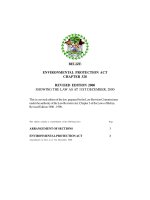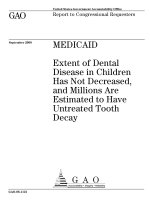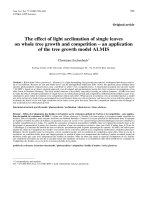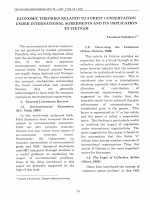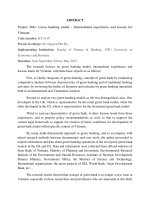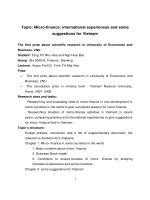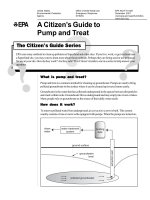Investment in environmental protection: International experiences and current situation in Vietnam
Bạn đang xem bản rút gọn của tài liệu. Xem và tải ngay bản đầy đủ của tài liệu tại đây (557.78 KB, 13 trang )
INVESTMENT IN ENVIRONMENTAL PROTECTION:
INTERNATIONAL EXPERIENCES AND CURRENT
SITUATION IN VIETNAM
Assoc. Prof. Dr Le Thu Hoa
Dr. Nguyen Cong Thanh
Faculty of Urban & Environmental Economics and Management,
National Economics University, Hanoi, Vietnam
Abstract
The economic growth in Vietnam has not been without cost as the natural
environment - forests, biodiversity and coastal zones-came under additional pressure.
To address the situation with the aim of proactive prevention, the Prime Minister
issued the Directive No. 25/CT-TTg, dated 31/8/2016, on some urgent missions and
solutions to protect environment. In Article 3, item (c) of the Directive, the Prime
Minister requested MPI “to study and regulate a specific level of environmental
expenditures in total amount of investments for investment projects”. Our review of
international experiences shows that the proportion of Pollution Abatement Capital
Expenditures to total firms’ capital expenditures in U.S. is about 3,5 - 5,1%. The
industries requiring higher levels of environmental capital expenditures include: (1)
Petroleum and coal products, (2) Primary metal industries; (3) Paper and all ied
products, and (4) Chemicals and allied products. In Vietnam, the level of investment in
environmental protection is relatively low. Some surveys of enterprises in Vietnam
show that less than 2% of all surveyed enterprises indicated the purpose of their
investment to meet environmental requirements. With the lessons from international
experiences, requirements on the rate (3-5%) of investment for the environment in the
total investment of investment projects can be identified as one of the criteria for
appraisal and approval of EIA reports of investment projects in Vietnam.
Keywords: environmental protection, environment impact assessment (EIA),
investment projects
1. Introduction
In recent years, Viet Nam has exerted its own resources and with the support of
international communities to promote socio-economic development and to improve the
living standard of Vietnamese people. In recent economic forecasts, the World Bank
predicts economic growth of Vietnam will exceed 6 percent until 2019, among the world‘s
fastest. In accordance with the economic growth, Vietnam‘s GDP per capita has reached an
666
estimated US$2,215 at the end of 2016. In 2016, Viet Nam commenced the implementation of
the 5-year socio-economic development plan 2016 - 2020 with the aims at achieving a
target of US$3,000 per capita. These achievements, however, have not been without cost
as the natural environment - forests, biodiversity and coastal zones-came under additional
pressure. Water and air quality and other parameters of urban environmental conditions
have stagnated or deteriorated. The Government of Viet Nam (GOV) has promulgated
legislations and embarked on programs and projects to mitigate the environmental impact
of urban and industrial expansion.
In 2012, the Government of Vietnam issued the "National Strategy for Green
Growth for 2011-2020 with a vision to 2050" (Hereafter referred to as Vietnam‘s Green
Growth Strategy or VGGS). The VGGS defines the green growth as an important part of
sustainable development that ensures rapid, effective, sustainable economic development
and significantly contributes to the implementation of Vietnam‘s national strategy on
climate change. It establishes the objectives for low carbon green growth and identifies
three strategic tasks: (1) Reducing greenhouse gas emission; (2) Greening production; (3)
Greening lifestyles and consumption.
Following the official adoption of VGGS in 2012, the Government of Vietnam
issued the Vietnam National Action Plan on Green Growth (VGGAP) in March 2014
through Prime Minister Decision No. 403/QĐ-TTg. The VGGAP (2014-2020) outlines 66
distinct intervention areas (programs, projects) and related responsibilities among
Ministries, Departments and Agencies (both leading and collaborating) for designing and
implementing these initiatives. According to the GGAP, these activities are categorized
into four key areas: (1) awareness raising; (2) institutional improvement; (3) economic
restructuring in sectors, localities and enterprises; (4) innovative technologies.
In the past years, the activities of environment protection have achieved some
noticeable results. However, environmental pollution from industrial production has been
still an increasing problem, creating serious environmental incidents affecting people‘s
activities; producing negative impacts on the implementation of the national Green Growth
Strategy and sustainable development. Reasons for this situation are that legal regulations
are not suitable with the realities; lack of regulations and criteria for appraising investment
projects, producing technologies and waste treatment activities of enterprises, especially,
no specific criteria for the proportion of environmental expenditures in total amount of
investment for various types of investment projects.
To address the situation with the aim of proactive prevention, the Prime Minister issued
the Directive No. 25/CT-TTg, dated 31/8/2016, on some urgent missions and solutions to
protect environment. In Article 3, item (c) of the Directive, the Prime Minister requested MPI
―to study and regulate a specific level of environmental expenditures in total amount of
investments for investment projects‖. This study will provide useful information to contribute
to the implementation of Directive No. 25/CT-TTg. The study results may also be helpful to
design relevant policies for green growth in the future in Vietnam.
667
2. Research methodology
2.1. Overall approach
To achieve the objectives, this research will use both qualitative and quantitative
methodology to examine environmental expenditures of industrial investment projects in
previous studies, international experiences and case studies. With the aim of collecting
more information about environmental costs, we plan to select Vietnam‘s case studies for
more detailed examination. Selected cases will aim to reflect key industrial production in
relation to environmental management performance. The fieldwork methodology will use
semi-structured interviews and focus groups to contrast the informants‘ viewpoints. The
collected data will be continuously analyzed during the fieldwork to guide the data
collection in subsequent rounds. Secondary data will be used to supplement the
information gained from the in-depth interviews in order to draw an overall picture
relevant to current status in Vietnam. Policy recommendation on levels of investment in
environment pollution treatment will be proposed for investment projects in industrial
production; and draft of legislative documents will be submitted to MPI to propose for
Government decision.
2.2. Key research steps
Collecting and examining international experiences on environmental treatment
costs in industrial production: relevant international documents, data on investment
amount for environmental protection in USA, Japan, Europe, China… will be collected
and examined to support environmental requirements for investment projects.
Collecting and examining current state of environmental treatment costs in
industrial production in Vietnam. The current status about investment for environmental
pollution treatment in Vietnam will be synthesized based on: (1) approved reports of
environmental impact assessment (EIA); (2) consultation about results of environmental
inspection during the project operation; (3) reports on environmental management
accounting and cleaner production initiatives in industrial production; (4) field visits to
some industrial companies.
3. Results
3.1. Concepts of investment for environmental protection
The natural environment provides conditions for economic development, and
economic development can be considered as the basis for the transformation of the natural
environment. It is a close relationship that any nation should be concerned about in its
development planning process. With that view, economic development along with
environmental protection is the approach chosen by many countries in the world. In
Vietnam, the Law on Environmental Protection (LEP) clearly states:
"Environmental protection are activities of preserving, preventing and restricting
negative impacts on the environment; responding to environmental incidents; overcoming
pollution, degradation; improving and restoring the environment; exploit and use natural
668
resources in the ways of keeping the environment healthy" (Clause 3, Article 3 of the Law
on Environment Protection, 2014).
In the world, environmental protection issues are being paid attention by many
organizations and enterprises towards a world of sustainable development. As businesses
increasingly play an important role in green production, investment in environmental
protection has become a topic of widespread interest and has been incorporated into
important programs of national environmental policies and international cooperation
organizations.
Investment in environmental protection is a type of investment for development,
because the protection and maintenance of the environment is a condition for sustainable
economic development. In economic management, investment is the process of using the
resources at present to carry out activities to obtain results, accomplish certain goals in the
future. Environmental protection investment in enterprises is often reflected through
investment activities related to compliance with environmental regulations by state
management agencies and voluntary pollution prevention or market forces. .
In the current trend, enterprises which are the largest source of pollution are playing
an increasingly important role in investing in environmental protection. Protecting the
environment is not only an obligation for the business, but is gradually benefits for the
business in affirming the brand, increasing its value, gaining trust in the market towards the
sustainable development for both enterprises and the community. In addition, in order to
succeed in integration, enterprises must comply with new international environmental
regulations in production, business and consumption.
3.2. International experience on levels of investments in environmental protection
Currently, two trends are becoming common in many countries around the world,
namely: (i) investment in environmental protection is increased in national income and (ii) The
private sector will play a major role in environmental protection. For example, the average
gross national investment for environmental protection in European countries accounts for
about 2.1% of their total GDP. In particular, private sector investment accounted for 59%. In
the following sections, information about the level of investment for environmental protection
will be presented in more detailed in case studies in the US, Canada and China.
Environmental expenditures in United States
The Pollution Abatement Costs and Expenditures (PACE) survey1 is the most
comprehensive national source of pollution abatement costs and expenditures related to
environmental protection for the manufacturing sector of the United States. The PACE
survey collects facility-level data on pollution abatement capital expenditures and operating
costs associated with compliance to local, state, and federal regulations and voluntary or
market-driven pollution abatement activities. The PACE survey was conducted annually
1
For more information, refer to (accessed on 9 Mar 2018
669
between 1973 and 1994 (with the exception of 1987), but was discontinued after 1994 by the
U.S. Census Bureau for budgetary reasons. Recognizing the need for this type of data, the
EPA provided the necessary funding to conduct a PACE survey in 2000 to collect pollution
abatement costs and expenditures for 1999. The survey has not been administered since 2000
in order for the EPA to evaluate the PACE survey and guidelines. The 2005 PACE survey is
the result of a multi-year redevelopment/evaluation effort by the EPA to ensure the accuracy
of the survey responses. Because of the limited amount of resources, there are no efforts
underway at present to administer another PACE survey and collect more recent information
than the data collected and reported for the year 2005.
The PACE surveys before and after 1994 applied different industrial codes, hence
the two datasets are presented in separate tables. Tables 1 and 2 show that the proportion
of Pollution Abatement Capital Expenditures to total firms’ capital expenditures in U.S.
is about 3,5 – 5,1%. The industries requiring higher levels of environmental capital
expenditures include: (1) Petroleum and coal products, (2) Primary metal industries; (3)
Paper and allied products, and (4) Chemicals and allied products.
Table 6. Proportion (%) of Pollution Abatement Capital Expenditures to Annual
Survey of Manufactures (ASM) new capital expenditures in U.S. in 2005 and 1999
Average
3,5
13,2
10,7
2005
4,0
15,8
11,4
1999
3,1
10,7
9,9
Paper mfg
9,5
10,2
8,7
Chemical mfg
Nonmetallic mineral product mfg
6,1
4,3
7,5
4,2
4,7
4,3
Wood product mfg
Food mfg
3,7
3,3
4,7
3,7
2,7
2,8
Leather & allied product mfg
Textile mills
3,2
2,6
1,7
3,6
4,7
1,7
Fabricated metal product mfg
Furniture & related product mfg
2,5
1,9
2,2
2,2
2,9
1,6
Beverage & tobacco product mfg
Electrical equipment, appliance, & component mfg
1,5
1,3
2,3
1,7
0,7
0,9
Plastics & rubber products mfg
Machinery mfg
1,3
1,2
1,4
0,7
1,2
1,7
Transportation equipment mfg
Printing & related support activities
1,2
1,1
1,7
1,6
0,7
0,7
Textile product mills
Computer & electronic product mfg
1,1
0,8
1,1
1,0
1,0
0,6
Miscellaneous mfg
0,4
0,6
0,3
All industries
Petroleum & coal products mfg
Primary metal mfg
670
Review of other previous studies
In Canada, the Survey of Environmental Protection Expenditures is conducted
every two years. The survey collects operating and capital expenditures made by primary
and manufacturing industries in response to, or in anticipation of, environmental
regulations and conventions. It also reports the use of environmental management
processes and technologies including those used to reduce greenhouse gas emissions by
Canadian businesses. The collected data in 2006 show that the oil and gas extraction
industry spent more on environmental protection than any other industry, accounting for
almost one-third of the total. The second highest spender was the petroleum and coal
products industry, accounting for approximately 10% of total environmental protection
expenditures. Investments by Canadian oil and gas producers, most of which operate in
Alberta, in areas such as pollution abatement and control, waste management, pollution
prevention, and reclamation and decommissioning totaled over $1.7 billion in 2006. Put in
perspective, for every $100 invested by the oil and gas extraction industry, $4 (4%) was
invested in environmental protection. Nationally, the petroleum and coal products
industry was the second largest investor in environmental protection ($596 million) as that
industry continued to upgrade refineries to meet new Sulphur regulations. Environmental
protection capital expenditures represented about $20 (20%) out of every $100 invested
by the petroleum and coal products industry. 2
Charles et al. (2012) provided information about proportion of environmental
capital spending to total capital expenditures of 45 firms in United States. The 45 firms
disclosed their environmental capital expenditures in at least one year over the sample
period of 1993 - 2005, and there are 433 firm-year disclosures of this spending over the
investigation period. The sample firms represent 16 different industries (based on two-digit
primary SIC codes) with the largest representation, coming from the 28xx (chemical and
allied products) classification. The sample firm size (based on 2004 revenues) ranges from
$3.5 billion to $291.2 billion with a mean (median) of $22.8 billion ($9.8 billion). In
general, the firms were profitable (mean 2004 ROA of 6.4 percent), and well-leveraged
(mean 44.9 percent debt-to-capital ratio in 2004). The 2004 capital intensity of the
companies (net property, plant and equipment (PPE) divided by total assets) ranged from
7.0 percent to 68.0 percent with a mean (median) of 28.2 percent (24.7 percent). Charles et
al. (2012)‘s observations show that firms‘ environmental capital spending ranged from
0.07 percent of total capital expenditures on the low end to 55.34 percent at the high end.
The mean firm-year environmental capital spending was 6.59 percent of companies’
total firm-year capital spending amounts.
2
Source: (accessed on 9 Mar 2018)
671
Table 7. Proportion (%) of Pollution Abatement Capital Expenditures to Annual Survey of Manufactures (ASM) new capital expenditures in
U.S. in 1973 - 1993
Avg 1993 1992 1991 1990 1989 1988 1986 1985 1984 1983 1982 1981 1980 1979 1978 1977 1976 1975 1974 1973
All industries
5,1
Petroleum and coal products
19,3 42,4 41,3 24,8 22,0 12,5 18,5 16,5 8,4
8,3 10,6 10,8 11,5 14,7 16,3 18,3 16,6 15,6 23,0 25,1 29,1
Primary metal industries
11,6 10,2 10,5 11,5 8,6
7,2
6,6
7,1
5,4
6,5
5,9 12,2 11,5 13,5 0,2 16,9 19,7 20,0 20,0 17,2 21,4
Paper and allied products
10,5 10,0 12,9 13,7 9,9
8,0
5,8
4,5
5,3
1,2
4,6
6,1
6,1
6,5
9,6
Chemicals and allied products
10,2 13,3 14,1 12,9 12,2 8,9 10,1 7,9
9,0
5,5
5,6
6,9
7,9
8,9
9,7 10,5 12,5 13,2 12,3 10,6 12,4
Leather and leather products
7,3 14,0 7,2 15,1 7,3
3,0
4,0
4,0
1,1
1,9
Stone, clay and glass products
6,1
5,4
6,3
6,5
4,7
3,4
2,8
3,6
2,2
3,5
5,5
4,6
7,3
5,0
5,6
4,9
8,1
7,0 11,0 13,1 10,8
Lumber and wood products
4,4
4,7
5,8
9,0
5,6
3,1
2,6
2,0
2,1
2,9
2,1
2,5
4,4
4,0
4,5
4,4
4,8
4,1
5,9
6,0
6,6
Food and kindred products
3,8
2,6
3,6
5,1
2,8
3,1
2,8
2,7
2,2
2,4
2,6
2,5
2,9
3,6
3,6
3,6
4,7
5,4
5,3
6,6
8,2
Furniture and fixtures
3,8
4,6
3,1
3,3
2,6
1,5
3,0
2,7
1,9
1,6
1,5
2,7
2,9
2,2
4,3
2,2
3,2
9,4
9,6
8,1
5,7
Tobacco products
3,2
4,7
3,9
1,5
2,1
2,7
1,9
1,6
0,0
1,2
1,2
0,4
2,7
6,2
8,4
5,8
3,0
Fabricated metal products
3,0
2,4
3,3
4,3
3,6
3,3
3,5
3,0
2,7
3,3
2,5
2,3
1,7
1,9
2,0
1,9
3,2
3,3
3,7
4,6
3,7
Transportation equipment
2,9
2,6
2,9
2,8
3,7
2,9
2,9
4,8
4,4
2,6
1,9
1,5
2,6
3,4
2,8
2,4
1,8
2,5
2,7
3,3
4,0
Textile mill products
2,4
1,8
1,9
2,7
2,0
1,3
0,8
1,6
1,3
1,0
1,2
1,4
2,8
4,0
2,9
4,4
3,1
4,9
4,3
2,7
2,6
Instruments and related products
2,0
2,9
2,7
2,3
2,1
1,9
0,8
0,8
1,0
1,0
1,2
1,4
2,0
1,6
1,6
1,5
2,7
4,1
3,7
1,9
1,9
Electronic and other electric equipment
1,8
2,0
1,7
0,3
1,9
2,2
1,9
1,4
1,3
1,1
1,3
1,4
1,5
1,3
2,0
2,0
2,3
2,6
2,8
2,3
2,6
Miscellaneous manufacturing industries
1,7
2,1
1,8
1,6
2,2
1,2
1,6
0,9
1,4
1,1
0,7
1,9
1,5
1,6
0,8
1,9
3,9
3,5
Rubber and miscellaneous plastics products
1,7
1,5
2,3
1,9
2,2
1,7
1,1
1,2
0,1
1,2
1,3
1,1
1,3
1,0
1,1
1,2
3,2
2,8
2,8
2,6
1,9
Industrial machinery and equipment
1,4
1,5
2,2
1,8
1,3
2,1
1,1
0,7
0,8
0,5
0,8
0,9
0,8
0,9
1,2
1,4
2,2
2,0
1,8
2,0
2,4
Printing and publishing
0,8
0,9
0,9
0,7
1,2
0,6
1,4
0,6
0,8
0,5
0,4
0,5
0,4
0,5
1,0
0,6
0,5
0,3
1,2
2,4
0,7
672
6,8
6,8
6,4
5,2
3,7
3,9
3,6
2,9
2,5
2,9
3,2
4,1
4,4
4,3
5,3
6,2
7,4
8,0
7,6
7,8
9,1 13,5 16,2 22,3 21,5 22,2
1,5
12,3 19,5 9,0
4,2
5,3
3.3. Investments in environmental protection in Vietnam
3.3.1. The legal and regulatory context
The 2014 Law on Environmental Protection (LEP) provides a legal framework for
managing environmental issues in Viet Nam. The LEP was firstly promulgated in 1993 and
was revised twice in 2004 and 2014. The LEP requires firms in some specific industries to
conduct environmental impact assessment (EIA), and they only have the right to start or
continue their business only when their EIA reports are approved. Other firms are required
to prepare a simpler commitment to environmental protection statement. In 2016,
regulations of administrative penalties on environmental violations have been revised
(Decree 155/2016/ND-CP). The monetary penalties have maximum levels of 1 billion for
violating individuals and 2 billions for violating firms.
Environmental Impact Assessments (EIAs) are suggested as tools for promoting
firms‘ investments in environmental protection. EIAs are scientific processes that evaluate
the potential environmental impact of development projects before making decisions about
undertaking the projects. Governments use EIAs to identify and manage the effects of
economic development on the natural environment. In Viet Nam, EIA reports provide a legal
basis for environmental management agencies to approve project investments. The LEP
1993 was the first Vietnamese legislation to regulate EIAs. The current EIA framework in
Viet Nam is regulated by the 2014 LEP; Decree No 18/2015/ND-CP of Government dated
14 February 2015 on environmental protection planning, strategic environmental assessment,
environmental impact assessment and environmental protection plan; and Circular No.
27/2015/TT-BTNMT 29 May 2015, issued by MONRE on strategic environmental
assessment, environmental impact assessment and environmental protection plan. The 2014
LEP has revised and updated EIA regulation, and has 11 articles ((Articles 18-28) dealing
with EIAs, compared to 6 articles (Articles 18-23) in the previous LEP. For example, there is
a new article (Article 21) about consultation with organizations and communities affected by
proposed projects. The EIA policy system has also improved, and MONRE has issued
guidelines on EIA for specific project types, such as the development of industrial zones,
urban development, breweries and beverages, thermal power plants, textile factories –
dyeing, cement plants, hydropower, pulp and paper plant, for example (Tuan, 2017).
Despite increasing efforts, available evidences suggest that environmental
regulations in Vietnam have been of little success with respect to business compliance.
First, many goals specified by the Vietnam government could not be reached and had to be
adjusted to more humble levels (Anh, 2016). Second, low levels of compliance have been
found in important industries such as food, paper, and leather (Thanh, 2009; Dung, 2011;
Thanh and Truong, 2013). Although EIAs have the potential to prevent environmental
pollution, EIA practices in Viet Nam still reveal many inadequacies and weaknesses in
both the quality of EIA reports and implementation processes (Clausen et al., 2011; Tuan
et al., 2012). Meaningful public participation and information disclosure are important to
ensure effective EIAs (Clausen et al., 2011). A key problem is the lack of meaningful
public consultation. For example, Commune Peoples Committees are only required to call
a formal meeting with community representatives during the EIA process (Item 6, Article
673
12, Decree No 18/2015/ND-CP of the Vietnamese Government). There is no requirement
for open public involvement and no requirement or guidance provided about effective
consultation methods. During project appraisal, there is also no mechanism for authorities
to receive public feedback.
3.3.2. Status of investment in environmental protection of Vietnamese enterprises
Based on a survey of EIA reports, summary information on investment for
environmental protection is presented in Table 3. For large investment projects (Nghi Son
Refinery, Formosa Steel Ha Tinh), the investment for environmental protection is
estimated at 11% - 14% of total investment. Environmental investment is relatively high,
as these are projects in the field that have tentative big impacts on the environment, such as
petrochemicals and primary metal industriess. In addition, these projects are invested by
large international corporations, so the level of environmental investment committed in the
EIA report is equivalent to the environmental protection investment of enterprises in the
same field of activity in the US (for more information, refer to Tables 1 and 2).
However, the level of investment in domestic projects, reviewed in Table 3, is
relatively low. The group of coal mining projects has an average level of environmental
protection investment of 3%, very low compared to 19.3% of the environmental protection
investment of the coal and oil industry in Table 2. Also related to using coal, the average
environmental protection investment of coal-based power plants is 6.6% <19.3%. Mineral
resource extraction projects such as rare earths and titanium mining have less than 1% of
environmental protection investment, while environmental investment of the US mining
industry accounts for 6.1% of total investment (please refer to Table 2).
Table 8: Summary of capital cost of environmental protection committed in EIA
reports of investment projects
No.
Project
Industry
Total
Environmental
Rate of
investment
investment
environmental
investment (%)
(mill. VND) (mill. VND)
1
Nghi Son Oil Refinery
Petroleum
136.800.000
15.059.400
11,0
2
Steel Complex and Son
Duong Port Formosa Ha
Tinh phase 1-1
Metallurgical
179.642.568
23.114.184
12,9
3
Khe Sim coal mine
Coal mining
125.123
14.198
11,3
4
Nam Mau coal mine Uong Bi Coal Company
Coal mining
1.981.950
2.838
0,1
5
Enhancing capacity of
Thong Nhat Coal
Company
Coal mining
595.250
2.610
0,4
6
Expansion of coal mines
of Thong Nhat Coal
Company
Coal mining
1.494.529
4.694
0,3
7
Cam Pha Thermal Power
Plant
Electricity
7.956.977
644.959
8,1
674
No.
Project
Industry
Total
Environmental
Rate of
investment
investment
environmental
investment (%)
(mill. VND) (mill. VND)
8
Vinh Tan Thermal Power
Plant 4
Electricity
35.949.700
1.900.055
5,3
9
Thai Binh Thermal Power
Plant
Electricity
17.247.042
1.117.612
6,5
10
Ha Long rare earth
processing and material
processing plant
Mining
92.250
903
1,0
11
Sandstone titanium mine,
Vinh Tu and Vinh Thai
communes, Vinh Linh
district, Quang Tri
province
Mining
30.404
117
0,4
12
Raising the capacity of the Beverage
VBL Danang Brewery
2.103.904
148.062
7,0
13
Factories for prefabricated Construction
concrete, prefabricated
materials
concrete components and
unbaked building
materials
100.000
2.000
2,0
14
Textile, garment, dyeing
and textile accessories
factory Tam Thang
1.596.000
228.000
14,3
Textile
Source: EIA Reports of the projects
Previous enterprise surveys also showed that investment in environmental
protection of enterprises was quite low. In general, investment and operating costs for
environmental protection represent a very small share of total investment and production
costs of enterprises. Approximately 40% of survey respondents have invested in
environmental protection activities and have regular expenses for environmental
protection. In addition, only 24% of enterprises have built environment management
system, such as ISO14001. Among enterprises that invest in environment protection, more
than 60% of enterprises only invest one time for environmental protection activities since
its establishment. In addition, about 74% of enterprises have the ratio of investment costs
for environmental protection activities is less than 10% of the initial investment cost of
enterprises.3 In particular, the average cost of regular activities for environmental
protection of enterprises only accounts for more than 1% of the total cost of production.
The results of recent surveys will provide more information on investment for
environmental protection of Vietnamese enterprises.
3
According to the project ―Đánh giá thực trạng tình hình đầu tư cho đ i mới CNTTMT của DN Việt Nam”,
Bộ Kế hoạch và Đầu tư - 2016
675
The SME survey by the Central Institute for Economic Management
Small and medium enterprises (SMEs) and the private sector have been the
dominant force in the Vietnamese economy (CIEM, 2016). SMEs have seen exponential
growth over the last decade. The General Statistics Office of Viet Nam reported 49,203
registered private enterprises in 2013, which is two times more than in 2003 when 25,653
firms were observed. The number of firms in the manufacturing sector grew three times in
the same period: from 16,916 enterprises registered in 2003 to 58,688 in 2013. Non-state
enterprises employed 6.8 million employees in 2013, which is 59.3 per cent of the total
enterprise workforce. This is three times more than in 2003 when non-state enterprises
employed 2 million workers. The number of employees in manufacturing increased from
2.6 million in 2003 to 5.3 million in 2013. These numbers show a clear trend of consistent
growth in the SME sector in Vietnam.
In 2015, the Central Institute for Economic Management (CIEM) conducted a
survey of 2,628 SME enterprises in manufacturing sector. The surveyed enterprises operated in
ten provinces, namely the cities of Ha Noi, Hai Phong, Ho Chi Minh City (HCMC), Ha Tay,
Phu Tho, Nghe An, Quang Nam, Khanh Hoa, Lam Dong and Long An provinces. On average,
there were more investments in environmental equipment in 2015 than in 2013. The total
amount invested increased by around 30 per cent, from 163 billion VND in 2013 to 214 billion
VND in 2015. The SMEs invested the most in equipment for waste disposal (around 130
million VND). This is the most remarkable increase as the investment in this equipment was
only 21 million VND in 2013. Investments in equipment for treating water pollution and air
quality were at around 25 million VND in 2015, substantially declining from 47 and 36 million
VND, respectively, since 2013. The investments in environmental equipment are more
recent—the most intensive ones being made in 2012, right after the Environmental Law came
to force. On average, environmental equipment is 7 years old.
Regarding the level of environmental protection investment, surveyed results on
the investment purpose of enterprises show that the main purpose is to increase
productivity rather than to meet environmental requirements. Less than 2% of all surveyed
enterprises in 2005, 2007, 2009, 2011, 2013 and 2015 indicate the purpose of the
investment to meet environmental requirements.
Figure 4: Investments in equipment for environmental standards
(million VND, real values)
2013
2015
150
100
50
0
Waste
disposal
Water
quality
Air quality
Noise
Heat
Fire
Lighting
Source: CIEM (2016)
676
4. Conclusions
Along with rapid industrialization and poverty reduction, there is a high cost to
the natural environment in Vietnam. According to the Environmental Performance
Index,4 in 2016 Viet Nam ranked in the top 10 countries with the worst air quality (Hsu
A. et al., 2016). Environmental pollution from production activities continues to increase,
causing many incidents causing serious environmental pollution, affecting people‘s
activities and the implementation of the National Strategy for Sustainable Development.
Business investment for environmental protection plays a very important role in ensuring
the sustainable development of enterprises, contributing to improving the competitiveness
and image of enterprises, while contributing to the sustainable development of the country.
The results of previous surveys show that businesses are basically aware of the
long-term benefits of environmental protection, but the immediate investment and costs of
environmental protection are still felt by businesses as a financial burden. Investment and
regular costs for environmental protection accounts for a very small share of total
investment and production and business costs of enterprises. Survey results of small and
medium enterprises on the purpose of investment implementation of enterprises showed
that less than 2% of the total surveyed enterprises responded to meet the requirements of
the environment.
In order to promote environmental investment, previous research has shown that the
idea from the enterprises themselves is to tighten environmental management and
strengthen state management oversight. Economic instruments such as the application of
environmental protection fees are also management tools that can increase the
environmental investment of enterprises. The application of regulations on requirements
and proportion of investment capital for environmental pollution treatment for investment
projects may be criteria and tools for evaluation and selection of suitable investment
projects. with green growth goals.
Comprehensive PACE surveys in the US show that the cost of capital investment in
environmental protection in the total cost of capital invested by businesses is about 3.55.1%. Industries that require higher levels of environmental investment include: (1)
petroleum and coal products, (2) main metallurgical industry; (3) Paper and related
products, and (4) Chemicals and related products. With experience in the United States,
regulations on the rate (3-5%) of investment for the environment in the total investment of
investment projects can be identified as one of the criteria for appraisal and approval of
EIA reports of investment projects.
References
1. Anh, Ho Hoang (2016). Business Compliance with Environmental Regulations:
Evidence from Vietnam. EEPSEA Research Report 2016-SRG4.
4
The Environmental Performance Index, created by researchers at the Yale University, is a worldwide
ranking for 180 countries ( accessed on 06/01/2018).
677
2. Charles, H. Cho, Freedman Martin and M. Patten Dennis (2012). "Corporate
disclosure of environmental capital expenditures: A test of alternative theories."
Accounting, Auditing & Accountability Journal 25(3): 486-507.
3. CIEM (2016). Characteristics of the Vietnamese business environment:
Evidence from a SME survey in 2015. Central Institute for Economic Management
(CIEM), Ministry of Planing and Investment, Vietnam.
4. Clausen, Alison, Hoang Hoa Vu and Miguel Pedrono (2011). "An evaluation of
the environmental impact assessment system in Vietnam: The gap between theory and
practice." Environmental Impact Assessment Review 31(2): 136-143.
5. Dung, Nguyen Mau (2011). "Compliance of paper-making plants with
regulations on wastewater management in Bac Ninh Province, Vietnam." Environment,
Development and Sustainability 13(1): 35-50.
6. Hsu A. et al. (2016). 2016 Environmental Performance Index. New Haven, CT:
Yale University. Available: www.epi.yale.edu.
7. Thanh, Le Ha (2009). Assessing the impacts of environmental regulations on the
food processing industry in Vietnam. EEPSEA Research Report No. RR8.
8. Thanh, Le Ha and Dinh Duc Truong (2013). "Compliance of leather tanning
industry with environmental regulations in Vietnam." Journal of Economics and
Development 15(2): 54-78.
9. Tuan, Can Anh, Hoang Xuan Co and Nguyen Thi Hoang Lien (2012). "Potential
Uses of Environmental Impact Assessment Report for Environmental Dispute Resolution
in Vietnam." VNU Journal of Science, Natural Sciences and Technology: 64-73.
10. Tuan, Nguyen Sy (2017). The recent revision of the EIA system in Vietnam.
Environmental
Impact
Assessment
Network
( accessed on 8 Jan 2018).
678
